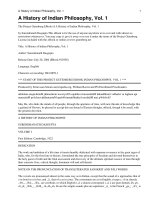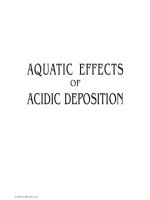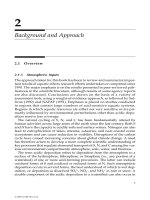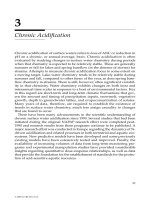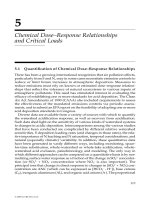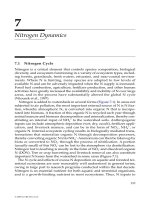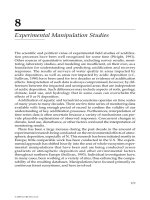AQUATIC EFFECTS OF ACIDIC DEPOSITION - CHAPTER 1 pptx
Bạn đang xem bản rút gọn của tài liệu. Xem và tải ngay bản đầy đủ của tài liệu tại đây (874.64 KB, 20 trang )
AQUATIC EFFECTS
OF
ACIDIC DEPOSITION
© 2000 by CRC Press LLC
LEWIS PUBLISHERS
Boca Raton London New York Washington, D.C.
AQUATIC EFFECTS
OF
ACIDIC DEPOSITION
Timothy J. Sullivan
© 2000 by CRC Press LLC
This book contains information obtained from authentic and highly regarded sources. Reprinted material
is quoted with permission, and sources are indicated. A wide variety of references are listed. Reasonable
efforts have been made to publish reliable data and information, but the author and the publisher cannot
assume responsibility for the validity of all materials or for the consequences of their use.
Neither this book nor any part may be reproduced or transmitted in any form or by any means, electronic
or mechanical, including photocopying, microfilming, and recording, or by any information storage or
retrieval system, without prior permission in writing from the publisher.
The consent of CRC Press LLC does not extend to copying for general distribution, for promotion, for
creating new works, or for resale. Specific permission must be obtained in writing from CRC Press LLC
for such copying.
Direct all inquiries to CRC Press LLC, 2000 N.W. Corporate Blvd., Boca Raton, Florida 33431.
Trademark Notice:
Product or corporate names may be trademarks or registered trademarks, and are
used only for identification and explanation, without intent to infringe.
© 2000 by CRC Press LLC
Lewis Publishers is an imprint of CRC Press LLC
No claim to original U.S. Government works
International Standard Book Number 1-56670-416-2
Library of Congress Card Number 99-058887
Printed in the United States of America 1 2 3 4 5 6 7 8 9 0
Printed on acid-free paper
Library of Congress Cataloging-in-Publication Data
Sullivan, Timothy, J., 1950-
Aquatic effects of acidic deposition / Timothy J. Sullivan.
p. cm.
Includes bibliographical references and index.
ISBN 1-56670-416-2 (alk. paper)
1. Acid deposition Enviromental aspects. 2. Acid pollution of rivers, lakes,
etc United States. I. Title.
TD427.A27 S85 2000
628.1
′
683—dc21 99-058887
CIP
1416fm Page iv Wednesday, February 9, 2000 11:35 AM
© 2000 by CRC Press LLC
To Debbie, Laura, and Jenna
1416fm Page v Wednesday, February 9, 2000 11:35 AM
© 2000 by CRC Press LLC
Acronyms
ABW Absaroka-Beartooth Wilderness
AERP Aquatic Effects Research Program
ALSC Adirondack Lakes Survey Corporation
ALTM Adirondack Long-Term Monitoring Program
ANC Acid neutralizing capacity
ANC
G
ANC as measured by Gran titration in the
laboratory
AQRV Air quality related values
ASI Acidic stress index
BMW Bob Marshall Wilderness
CAAA Clean Air Act Amendments
CALK Calculated ANC
CCA Canonical correspondence analysis
CEC Cation exchange capacity
CLIMEX Climate Change Experiment
DDF Dry deposition factor
DDRP Direct Delayed Response Project
DIC Dissolved inorganic carbon
DOC Dissolved organic carbon
ELS Eastern Lake Survey
ELS-I Phase I of the Eastern Lake Survey
ELS-II Phase II of the Eastern Lake Survey
EPA Environmental Protection Agency
ERP Episodic Response Program
EXMAN Experimental Manipulation of Forest Ecosystems
in Europe Program
FADS Florida Acid Deposition Study
FISH Fish in Sensitive Habitats Project
FLAG Federal Land Managers AQRV Group
FLM Federal Land Manager
GLAC Glacier National Park
GLEES Glacier Lakes Ecosystem Experiment Site
1416fm Page vii Wednesday, February 9, 2000 11:35 AM
© 2000 by CRC Press LLC
GRTE Grand Teton National Park
HBEF Hubbard Brook Experimental Forest, NH
HUMEX Humic Lake Acidification Experiment
IA Integrated Assessment
IAG Internal Alkalinity Generation Model
IAM Integrated Assessment Model
ILWAS Integrated Lake–Watershed Acidification Study
IWS Integrated Watershed Study
LAC Limits of acceptable change
LTM Long-term monitoring program
LTRAP Long Range Transboundary Pollution Program
MAGIC Model of Acidification of Groundwater in
Catchments
MAGIC-WAND Model of Acidification of Groundwater in
Catchments with Aggregated Nitrogen
Dynamics
MERLIN Model of Ecosystem Retention and Loss of
Inorganic Nitrogen
MPCA Minnesota Pollution Control Agency
NADP National Atmospheric Deposition Program
NAPAP National Acid Precipitation Assessment Program
NDDN National Dry Deposition Network
NIICCE Nitrogen Isotopes and Carbon Cycling in
Coniferous Ecosystems Model
NITREX Nitrogen Saturation Experiments Program
NIVA Norwegian Institute for Water Research
NLS National Lake Survey
NPP Net primary production
NPS National Park Service
NSS National Stream Survey
NSWS National Surface Water Survey
NTN National Trends Network
NuCM Nutrient Cycling Model
OTA Office of Technology Assessment
OWLS Object Watershed Link System
PIRLA Paleoecological Investigation of Recent Lake
Acidification
1416fm Page viii Wednesday, February 9, 2000 11:35 AM
© 2000 by CRC Press LLC
PIRLA-II Continuation of Paleoecological Investigation of
Recent Lake Acidification
PRL Proton reference level
PSD Prevention of significant deterioration
QA/QC Quality assurance/quality control
RADM Regional Acid Deposition Model
RAIN Reversing Acidification in Norway Project
RIA Randomized intervention analysis
RILWAS Regionalized Integrated Lake Watershed Acidifi-
cation Study
RMSE Root mean square error
ROMO Rocky Mountain National Park
SAMI Southern Appalachian Mountains Initiative
SBW Selway-Bitterroot Wilderness
SNSF Sur Nedbørs Virkning på Skog og Fisk (Acid Pre-
cipitation—Effects on Forest and Fish)—acidic
deposition research program in Norway
SOS/T State-of-Science/Technology Report
SWAP Surface Water Acidification Program
TAF Tracking and Analysis Framework
TOC Total organic carbon
UN/ECE United Nations/Economic Commission for Europe
USGS U.S. Geological Survey
VTSSS Virginia Trout Stream Sensitivity Study
VWM Volume weighted mean
WACALIB Weighted-averaging calibration
WLS Western Lake Survey
WMP Watershed Manipulation Project
WY Water year
YBP Years before present
YELL Yellowstone National Park
1416fm Page ix Wednesday, February 9, 2000 11:35 AM
© 2000 by CRC Press LLC
Acknowledgments
Aquatic Effects of Acidic Deposition
covers a wide range of topics and scientific
disciplines in which I have been involved in my own research over the last
two decades. My interest in these areas of research has been stimulated by a
large number of colleagues, many of whom are specialists in the various ele-
ments and fields of study covered in this book. This state-of-the-science sum-
mary was made possible by the concerted efforts of a great many scientists
who provided the research foundation that I have summarized and by my
interactions with them to enhance my understanding of the key elements that
are discussed.
I am very grateful to Jayne Charles who did all of the word processing
and worked extensively with the reference list. Susan Binder kindly
assisted with graphics and many other aspects of document production.
Many of the figures presented in the book were prepared by Susan, Kellie
Vaché, and Joe Bischoff.
Several colleagues kindly provided helpful comments on an earlier draft of
the book. These include Jack Cosby, Steve Kahl, and Kathy Tonnessen.
Funding to support preparation of this book was provided by the National
Oceanic and Atmospheric Administration, through the National Acid Precip-
itation Assessment Program; by the National Park Service, Air Resources
Division in Denver, through a grant to the University of Virginia; and the U.S.
Environmental Protection Agency, through a grant to Rensselaer Polytechnic
Institute. Much of my recent research that is summarized herein was sup-
ported by the U.S. Department of Energy, the National Park Service, the U.S.
Environmental Protection Agency, and the USDA Forest Service. None of the
previously mentioned agencies have cleared this book through their peer or
administrative review processes, and no official endorsement is implied.
I am very grateful to Mike Uhart, Kathy Tonnessen, Jack Cosby, John Kar-
ish, and Jon Zehr for assistance with funding arrangements, as well as sup-
port and encouragement.
1416fm Page xi Wednesday, February 9, 2000 11:35 AM
© 2000 by CRC Press LLC
Preface
In 1990, the U.S. National Acid Precipitation Assessment Program (NAPAP)
completed the initial phase of what was then the largest environmental
research program ever conducted. NAPAP research investigated the causes
and effects of, and mitigation strategies for, acidic atmospheric deposition
throughout the U.S. This massive environmental research and assessment
effort took 10 years to complete, involved hundreds of scientists, engineers,
and economists, and cost in excess of $500 million. The scientific culmination
of this research was embodied in a series of 27 State of Science and Technol-
ogy (SOS/T) Reports that were published in 1990. In addition, a policy report
was published in 1991 as the NAPAP Integrated Assessment. After 1990,
research funding for work on acidic deposition effects decreased suddenly
and substantially. However, many significant research programs were still in
progress and/or not yet published, especially in the areas of aquatic effects
of nitrogen and sulfur deposition. Results from these efforts appeared in the
scientific literature during the early 1990s. In addition, a suite of research
projects was initiated post-1990, albeit with somewhat lower funding levels
than were common during the heyday of the NAPAP research program.
These latter projects took advantage of the significant knowledge gains of the
1980s and, therefore, tended to be more focused and productive than earlier
research efforts. Many addressed significant knowledge gaps that had been
identified in the SOS/T reports, particularly regarding the interactions
between acidic deposition and other sources of natural and anthropogenic
acidity. As a consequence, a large body of scientific information related to
aquatic effects of atmospheric nitrogen and sulfur deposition has been pro-
duced since publication of the SOS/T series of reports. New findings have
added support to the state of scientific understanding in some areas, modi-
fied it in others, and led to the development of new paradigms and perspec-
tives in still other areas of research.
The primary aim of this book is to summarize and synthesize major
advancements since 1990 in the state of scientific understanding of the
aquatic effects of atmospheric deposition of nitrogen and sulfur. It is intended
to emphasize advancements in those aspects of aquatic effects research that
are of direct policy relevance. Thus, topics concerning quantification of the
magnitude of effects and recent developments in the area of predictive mod-
eling capabilities are deemed to be of great importance, for the purposes of
this book. Special attention is given to those aspects of aquatic effects research
that had either been poorly studied pre-1990 or for which major research
efforts have been completed in recent years. Topics of special interest include
virtually all aspects of nitrogen effects research, as well as the importance of
1416fm Page xiii Wednesday, February 9, 2000 11:35 AM
© 2000 by CRC Press LLC
natural sources of acidity, the influence of land use and landscape change on
the chemistry of drainage waters, and the role of short-term episodic events.
This book is intended as a teaching resource and reference source. It pro-
vides a comprehensive update on the state of scientific understanding
regarding an important environmental topic. It also illustrates the progres-
sion and refinement of the scientific knowledge base as research in this field
has evolved from general basic research to more narrowly focused efforts
aimed at answering specific questions. The target audience includes
advanced students of environmental science and engineering and applied
environmental practitioners. The latter group includes federal and state
land managers and environmental stewards, many of whom are tasked
with protecting sensitive natural resources from air pollution degradation
and overseeing and prioritizing efforts to mitigate past damage. The wealth
of recent knowledge gains summarized here will assist environmental pro-
fessionals in making informed judgments regarding air pollution sensitivi-
ties, effects, and remediation.
The effects of atmospheric nitrogen and sulfur inputs to watershed sys-
tems, and the interactions between such inputs and other natural and anthro-
pogenic features and stressors, provide an ideal framework for the study of
upland hydrobiogeochemistry. Such study requires understanding of the key
aspects of myriad disciplines and ecosystem compartments. Major compo-
nents include mass balance input–output calculations, the study of hydrolog-
ical flowpaths as water moves through the watershed system, and a wide
range of interactions between drainage water and soils, geological substrates,
and both terrestrial and aquatic biota. Understanding how hydrobio-
geochemical processes and cycles govern the response of the entire water-
shed to atmospheric inputs and the associated interactions with natural
features of the landscape, climate, and human disturbance aids our under-
standing of global ecosystems and the influence of human activities on eco-
system function and integrity.
Timothy J. Sullivan
1416fm Page xiv Wednesday, February 9, 2000 11:35 AM
© 2000 by CRC Press LLC
Contents
1 Introduction
1
1.1 1990 NAPAP Reports and Integrated Assessment 1
1.2 Scope 3
1.3 Goals and Objectives 4
1.4 Outline of State of Science Update 5
2 Background and Approach
7
2.1 Overview 7
2.1.1 Atmospheric Inputs 7
2.1.2 Sensitivity to Acidification 10
2.2 Chemical Response Variables of Concern 11
2.2.1 Sulfur 11
2.2.2 Nitrogen 12
2.2.3 Acid Neutralizing Capacity 13
2.2.4 pH 15
2.2.5 Base Cations 15
2.2.6 Aluminum 17
2.2.7 Biological Effects 18
2.3 Monitoring 20
2.4 Historical Water Quality Assessment Techniques 22
2.4.1 Historical Measurements 22
2.4.2 Paleolimnological Reconstructions 23
2.4.3 Empirical Relationships and Ion Ratios 26
2.5 Models 29
2.5.1 Empirical Models 29
2.5.2 Dynamic Models 32
3 Chronic Acidification
35
3.1 Characteristics of Sensitive Systems 36
3.2 Causes of Acidification 38
3.2.1 Sulfur 38
3.2.2 Organic Acidity 38
3.2.3 Nitrogen 47
3.2.4 Base Cation Depletion 50
3.2.5 Land Use 53
3.2.6 Climate 58
3.2.7 Fire 58
3.2.8 Hydrology 59
1416fm Page xv Wednesday, February 9, 2000 11:35 AM
© 2000 by CRC Press LLC
3.3 Effects of Acidification 60
3.3.1 Aluminum 60
3.3.2 Effects on Aquatic Biota 62
3.3.3 Effects on Amphibians 67
4 Extent and Magnitude of Surface Water Acidification
69
4.1 Northeast 70
4.1.1 Monitoring Studies 70
4.1.2 Paleolimnological Studies 78
4.1.3 Experimental Manipulation 81
4.1.4 Model Simulations 82
4.2 Appalachian Mountains 83
4.2.1 Monitoring Studies 85
4.2.2 Model Simulations 89
4.3 Florida 89
4.3.1 Monitoring Studies 92
4.3.2 Paleolimnological Studies 93
4.3.3 Model Simulations 94
4.4 Upper Midwest 94
4.4.1 Monitoring Studies 100
4.4.2 Paleolimnological Studies 101
4.4.3 Experimental Manipulation 102
4.4.4 Model Simulations 103
4.5 West 103
4.5.1 Monitoring Studies 111
4.5.2 Paleolimnological Studies 112
4.5.3 Model Simulations 112
5 Chemical Dose–Response Relationships
and Critical Loads
115
5.1 Quantification of Chemical Dose–Response
Relationships 115
5.1.1 Measured Changes in Acid–Base Chemistry 116
5.1.2 Space-for-Time Substitution 119
5.1.3 Paleolimnological Inferences
of Dose–Response 120
5.1.4 Model Estimates of Dose–Response 123
5.2 Critical Loads 124
5.2.1 Background 124
5.2.2 Progress in Europe 125
5.2.3 Progress in the U.S. and Canada 129
5.2.4 Establishment of Standards for Sulfur
and Nitrogen 132
6 Episodic Acidification
139
6.1 Background and Characteristics of Sensitive Systems 139
1416fm Page xvi Wednesday, February 9, 2000 11:35 AM
© 2000 by CRC Press LLC
6.2 Causes 143
6.2.1 Natural Processes 143
6.2.2 Anthropogenic Effects 144
6.3 Extent and Magnitude 146
6.4 Biological Impacts 151
7 Nitrogen Dynamics
155
7.1 Nitrogen Cycle 155
7.2 Environmental Effects 159
7.3 Nitrogen in Surface Waters 171
8 Experimental Manipulation Studies
175
8.1 Whole-System Nitrogen and/or Sulfur Enrichment
Experimental Manipulations 179
8.1.1 Gårdsjön, Sweden 179
8.1.2 Sogndal, Norway 181
8.1.3 Lake Skjervatjern, Norway 182
8.1.4 Aber, Wales 184
8.1.5 Klosterhede, Denmark 185
8.1.6 Bear Brook, ME 186
8.2 Whole-System Nitrogen Exclusion (Roof) Studies 187
8.2.1 Gårdsjön, Sweden 188
8.2.2 Ysselsteyn and Speuld, Netherlands 189
8.2.3 Klosterhede, Denmark 190
8.2.4 Solling, Germany 191
8.2.5 Risdalsheia, Norway 192
8.3 Climatic Interactions 193
8.4 Results and Implications 194
9 Predictive Capabilities
197
9.1 Model of Acidification of Groundwater in
Catchments (MAGIC) 198
9.1.1 Background and General Structure as Used
for the NAPAP 1990 Integrated Assessment 198
9.1.2 Recent Modifications to the MAGIC Model 201
9.1.2.1 Regional Aggregation and
Background Sulfate 201
9.1.2.2 Organic Acids 202
9.1.2.3 Aluminum 210
9.1.2.4 Nitrogen 212
9.1.3 Cumulative Impacts of Changes
to the MAGIC Model 215
9.1.4 MAGIC Model Testing and Confirmation
Studies 217
9.1.4.1 Lake Skjervatjern (HUMEX) 218
9.1.4.2 Risdalsheia (RAIN) 220
1416fm Page xvii Wednesday, February 9, 2000 11:35 AM
© 2000 by CRC Press LLC
9.1.4.3 Bear Brook (WMP) 222
9.1.5 Evaluation of MAGIC Projections 229
9.2 Nitrogen Models 232
10 Case Study: Adirondack Park, NY
237
10.1 Background and Available Data 237
10.1.1 ELS-I 239
10.1.2 ALSC 239
10.1.3 ELS-II 240
10.1.4 DDRP 240
10.1.5 PIRLA 240
10.1.6 ALTM 240
10.1.7 ERP 241
10.2 Watershed History 241
10.3 Lake-Water Chemistry 244
10.4 Organic Acidity 246
10.5 Role of Nitrogen in Acidification Processes 248
10.6 Role of Landscape and Disturbance
in Acidification Processes 252
10.7 Overall Assessment 256
11 Case Study: Class I Areas in the Mountainous West
259
11.1 Background 259
11.2 Sierra Nevada 265
11.2.1 Atmospheric Deposition 265
11.2.2 Surface Water Chemistry 266
11.2.3 Seasonality and Episodic Processes 267
11.2.4 Weathering and Cation Exchange 272
11.3 Rocky Mountains 273
11.3.1 Glacier National Park 275
11.3.2 Yellowstone National Park 278
11.3.3 Grand Teton National Park 280
11.3.4 Rocky Mountain National Park 284
12 Conclusions and Future Research Needs
301
Definitions 309
References 321
1416fm Page xviii Wednesday, February 9, 2000 11:35 AM
© 2000 by CRC Press LLC
1
1
Introduction
1.1 1990 NAPAP Reports and Integrated Assessment
It is well known that emissions of sulfur and nitrogen from power plants,
industrial facilities, and motor vehicles are linked to acidic deposition in
many parts of the world. The potential effects of acidic deposition on human
health and the environment became a major concern in the U.S. during the
1970s. Published reports linked acidic deposition with surface water acidifi-
cation, fish kills, damage to crops and materials, and adverse effects on
human health. The U.S. Congress considered actions to limit the emissions
into the atmosphere of acid-forming precursor materials, including sulfur
and nitrogen oxides, but information was limited regarding key processes
and cause/effect relationships.
In order to provide sufficient scientific information with which to make the
policy and regulatory decisions thought to be necessary for the protection of
the environment and public welfare, Congress mandated a 10-year research
program. The study was initiated under the Acid Precipitation Act of 1980
(PL 96-294, Title VII). An Interagency Task Force was established and the
National Acid Precipitation Assessment Program (NAPAP) was started.
NAPAP set out to answer important questions regarding the distribution of
acid-sensitive natural resources and their degree of sensitivity, emissions and
deposition of sulfur and nitrogen, source–receptor relationships and pro-
cesses, the probable extent of damage and potential need for mitigation, and
the availability of emission control technologies and mitigation options. Over
the next 10 years, NAPAP was to spend over $500 million and became, at the
time, what was the largest environmental research program ever conducted.
NAPAP developed a complex research and assessment process that
involved many hundreds of scientists throughout the U.S., Canada, and
Europe. Major objectives were to identify the causes and extent and magni-
tude of the effects of acidic deposition. The culmination of the NAPAP pro-
cess in 1990 included two major elements. A series of 27 State of Science and
Technology (SOS/T) Reports was prepared to summarize NAPAP’s technical
findings. The SOS/T reports addressed the full spectrum of acidic deposition
1416/frame/C01 Page 1 Wednesday, February 9, 2000 11:37 AM
© 2000 by CRC Press LLC
2
Aquatic Effects of Acidic Deposition
issues, from emissions (SOS/T 1) through valuation (SOS/T 27). Of these
reports, six covered aspects of acidic deposition aquatic effects (SOS/T 9
through 15) that were thought to comprise the most significant components
of environmental impacts. The second major element that culminated the
NAPAP effort was the Integrated Assessment (IA), a policy report to Con-
gress that was published in 1991.
In 1990, as the NAPAP research program was winding down, Congress
passed the Federal Acid Deposition Control Program as Title IV of the Clean
Air Act Amendments. The objective of Title IV was to reduce the adverse
effects of acidic deposition by reducing the emissions of sulfur dioxide in par-
ticular and to a lesser extent nitrogen oxides. Title IV stated that “reduction
of total atmospheric loading of sulfur dioxide and nitrogen oxides will
enhance protection of the public health and the environment.” An annual 10
million ton reduction in SO
2
emissions below 1980 levels was mandated and
targeted to electric utilities. In addition, a reduction in the emissions of nitro-
gen oxides of about 2 million tons from 1980 levels was specified. Upon full
implementation of the control program, reductions of about 40% in SO
2
emis-
sions and 10% in NO
x
emissions from the 1980 base year are anticipated.
There will be a national cap on the utility and industrial emissions of SO
2
at
this level, but a national cap on the emissions of NO
x
is not legislated, and
NO
x
emissions are projected to rise in the 21st century (NAPAP 1992). The
Federal Acid Deposition Control Program includes an innovative market-
based approach for achieving emissions reductions. Electric utilities have
been given considerable flexibility in achieving reductions in efficient, cost-
effective ways. Emissions allowances were issued to affected utility units
based on their historic fuel consumption and rate of SO
2
emissions. Each
allowance entitles a unit to emit 1 ton of SO
2
during or after the year specified
on the allowance. Once allocated, allowances are marketable, allowing
affected utilities to buy, sell, or bank allowances for future use (NAPAP 1992).
The first phase of implementation of the control program began January
1, 1995. About 260 units at the 110 highest emitting electric-utility plants in
the eastern U.S. were allocated emissions allowances. Phase II began Janu-
ary 1, 2000, and will affect about 2300 electric generating units throughout
the U.S., serving generators with capacities of 25 megawatts or greater.
When the program is fully implemented in 2010, the annual allocation of
emissions allowances will result in a national emissions cap of 8.9 million
tons of SO
2
from utility units. Nonutility SO
2
emissions will be capped at 5.6
million tons per year.
NAPAP expected a number of environmental benefits in response to imple-
mentation of Title IV. Lakes and streams acidified by acidic deposition were
expected to recover and support fish life. The risks of long-term soil degrada-
tion, ecosystem change, and loss of biological diversity were expected to be
reduced. Average visibility was expected to improve, allowing for increased
enjoyment of scenic vistas throughout the nation. Stresses on forest health
were expected to decrease, particularly in red spruce forests along the ridges
of the Appalachian Mountains (NAPAP 1991).
1416/frame/C01 Page 2 Wednesday, February 9, 2000 11:37 AM
© 2000 by CRC Press LLC
Introduction
3
It is too early to judge the extent to which reductions in acid deposition in
response to implementation of Title IV have or have not affected aquatic
chemistry or biology. Chemical effects owing to changes in atmospheric dep-
osition exhibit lag times of one to many years. Lags in measurable effects on
aquatic biota can be longer. Continued monitoring of water quality for sev-
eral years or more will be required to assess potential improvements that may
occur as a consequence of emissions reductions already realized. It is clear
that the concentrations of sulfate have decreased substantially in surface
waters in many areas of the eastern U.S. It is expected that the concentrations
of sulfate in surface waters will continue to decline in many areas, especially
in the Northeast. However, the extent to which surface water acidity may be
reduced in response to the expected continued decreases in sulfate concen-
trations as well as the extent to which biological recovery may be realized
remains uncertain.
NAPAP was reauthorized under the 1990 Clean Air Act Amendments (PL
101-549, Title IX). Although the research activities of NAPAP have been com-
pleted, additional assessment efforts have continued (e.g., NAPAP 1992,
1998). Since 1990, aquatic effects research has also continued, albeit at a much
lower level of effort than was seen during the 1980s. The recent research has
been more heavily focused, however, and has benefitted from the substantial
progress in understanding that was made during the heyday of acid deposi-
tion research funding of the previous decade. In many ways, the post-1990
research has been more efficient, and great strides have been made through
relatively modest levels of research funding. Many of the knowledge gaps
identified by NAPAP in 1990 have been filled in large part by a series of nar-
rowly focused, carefully designed studies. This book attempts to bring
together the key findings of these recent research efforts. By summarizing
advancements in the state of the science of aquatics effects since 1990, this
book contributes to NAPAP’s ongoing assessment activities.
1.2 Scope
The scope of this book is limited mainly to the aquatic effects of acidic depo-
sition. The NAPAP SOS/T reports included technical summaries for six
major areas of aquatic effects research:
SOS/T 9 Current Status of Surface Water Acid-Base Chemistry (Bak-
er et al., 1990a).
SOS/T 10 Watershed and Lake Processes Affecting Surface Water
Acid-Base Chemistry (Turner et al., 1990).
SOS/T 11 Historical Changes in Surface Water Acid-Base Chemis-
try in Response to Acidic Deposition (Sullivan, 1990).
1416/frame/C01 Page 3 Wednesday, February 9, 2000 11:37 AM
© 2000 by CRC Press LLC
4
Aquatic Effects of Acidic Deposition
SOS/T 12 Episodic Acidification of Surface Waters Due to Acidic
Deposition (Wigington et al., 1990).
SOS/T 13 Biological Effects of Changes in Surface Water Acid-Base
Chemistry (Baker et al., 1990c).
SOS/T 14 Methods for Projecting Future Changes in Surface Water
Acid-Base Chemistry (Thornton et al., 1990).
SOS/T 15 Liming Acidic Surface Waters (Olem, 1990).
This book summarizes recent advancements in scientific understanding
that pertain mainly to areas addressed in the SOS/T Reports 9, 11, 12, and 14,
with lesser treatment of areas addressed in the SOS/T Reports 10 and 13.
Liming issues (SOS/T 15) are not addressed. The greatest attention is focused
on recent findings in the U.S. Research elsewhere, especially in Europe, is dis-
cussed to the extent that it has complemented research in this country. An
effort is made to summarize what is new in the understanding of the science
of aquatic effects of acidic deposition, particularly in those research areas that
have direct bearing on policy-relevant assessment activities. Research com-
pleted and published between 1990 and 1998 receives the greatest attention.
1.3 Goals and Objectives
The major goal of this book is to summarize important scientific findings
regarding the aquatic effects of acidic deposition subsequent to publication
of the State of Science and Technology Reports by NAPAP in 1990. Because
the focus is on advancements in the science that are of direct policy relevance,
improved modeling capabilities and improved understanding of acidifica-
tion responses are of greater interest than specific advancements with respect
to the understanding of acidification processes.
Specific objectives of the analyses reported here are to
1. Clarify current understanding of the extent to which lake and stream
systems in the U.S. have experienced chronic acidification owing
to acidic deposition.
2. Quantify acidification dose–response relationships for sensitive surface
waters and recent advancements regarding specification of the crit-
ical loads of acidifying compounds required to protect sensitive
aquatic receptors from adverse effects.
3. Describe improvements in predictive capabilities for aquatic effects and
the results of model testing efforts.
4. Clarify current understanding regarding the relative importance of
various causes of surface water acidification.
1416/frame/C01 Page 4 Wednesday, February 9, 2000 11:37 AM
© 2000 by CRC Press LLC
Introduction
5
5. Describe recent advancements in the understanding of episodic acidi-
fication of surface waters.
6. Describe the results of ecosystem manipulation experiments that have
involved short-term increases or decreases in the levels of acidic
deposition to forested plots or small catchments.
1.4 Outline of State of Science Update
Chapter 2 provides background material on acidic deposition, the major
response variables of concern, and methods for evaluating acidification.
Chapters 3 through 9 comprise a state of science update on advancements in
acidic deposition aquatic effects research since 1990. The focus is on aspects
of aquatic effects that have direct relevance to public policy. Special emphasis
is given to advancements in the science that enhance our predictive capabil-
ities and shed light on dose–response relationships and the establishment of
critical loads of S and N for the protection of sensitive aquatic resources.
Chapters 10 and 11 comprise case studies of two important acid-sensitive
regions, one heavily impacted (Adirondack Mountains) and one highly sen-
sitive but only minimally impacted to date (high-elevation portions of the
Rocky Mountains and Sierra Nevada).
Chapter 3 covers advancements in the understanding of chronic acidifica-
tion. The characteristics of sensitive systems are described. Causes of chronic
acidification are reviewed and summarized, including an assessment of the
relative importance of each.
Current understanding of the extent and magnitude of chronic surface
water acidification is reviewed in Chapter 4 for the major acid-sensitive
regions of the U.S. An assessment is provided of the sensitivity of aquatic
resources to acidification from acidic deposition in each of the regions. Quan-
titative data are presented regarding the extent of acidification to date.
Chronic acidification chemical dose–response relationships are summa-
rized in Chapter 5 for those sites for which such data are available. Recent
steps toward the establishment of deposition standards or critical loads are
described.
Chapter 6 addresses issues related to episodic acidification, short-term
(hours to weeks) decreases in pH and ANC of surface waters in response to
increased hydrologic discharge associated with snowmelt or rain events.
Although less is known about episodic acidification than chronic acidifica-
tion, it is thought that the biological impacts of acidification are most often
first manifested as episodic, rather than chronic, processes. The characteris-
tics of aquatic systems that are sensitive to episodic acidification are pre-
sented. The extent and magnitude of episodic acidification are summarized
1416/frame/C01 Page 5 Wednesday, February 9, 2000 11:37 AM
© 2000 by CRC Press LLC
6
Aquatic Effects of Acidic Deposition
to the extent that they are known. Finally, the major causes of episodic acidi-
fication and their relative importance are described.
Chapter 7 provides a summary of recent advancements in the scientific
understanding of N dynamics and the aquatic effects associated with ele-
vated N deposition. The N cycle is described, with particular emphasis on
recent results from experimental field studies conducted during the past
decade in Europe.
Chapter 8 summarizes the results of recent selected examples of whole-eco-
system experimental acidification and de-acidification studies. Many such
experiments have been conducted in Europe and a few in the U.S. during the
past decade. The results of these experimental manipulation studies provide
invaluable quantitative dose–response data as well as a basis for extensive
testing of predictive models.
Chapter 9 covers aspects of acidification modeling of aquatic effects.
Selected new models are described for N effects modeling. Results of model
testing activities for S effects modeling are described, including recent modi-
fications to the MAGIC model, the principal modeling tool used thus far in
the U.S. and Europe to predict chronic acidification responses on a regional
as well as site-specific basis.
In Chapters 10 and 11, detailed case studies are presented for Adirondack
Park, NY, and for national parks and wilderness areas of the West, with par-
ticular emphasis on Sequoia National Park, CA, and Rocky Mountain
National Park, CO. A great deal of aquatic effects research has been con-
ducted within these three parks during the last one to two decades. Discus-
sion of major findings in these areas provides an excellent overview of recent
scientific developments in this research field as well as important insights
into key acidification processes.
Finally, in Chapter 12, major conclusions of the book are highlighted and
topics for future work are considered. Significant remaining knowledge gaps
in the state of scientific understanding are underscored. Major research and
assessment needs are described.
It is hoped that the recently completed and ongoing research highlighted
in this book will aid in the preparation of much improved NAPAP assess-
ments in the years 2000 and 2010. Acidic deposition research developments
provide an excellent example of the interconnections between environmental
research and public policy. Formulation of sound environmental policy
requires the kind of iterative research and modeling program that has been
implemented for acidic deposition.
1416/frame/C01 Page 6 Wednesday, February 9, 2000 11:37 AM
© 2000 by CRC Press LLC

